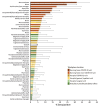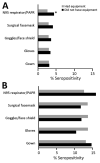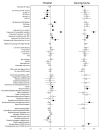Severe Acute Respiratory Syndrome Coronavirus 2 Seropositivity among Healthcare Personnel in Hospitals and Nursing Homes, Rhode Island, USA, July-August 2020
- PMID: 33622481
- PMCID: PMC7920685
- DOI: 10.3201/eid2703.204508
Severe Acute Respiratory Syndrome Coronavirus 2 Seropositivity among Healthcare Personnel in Hospitals and Nursing Homes, Rhode Island, USA, July-August 2020
Abstract
Healthcare personnel are recognized to be at higher risk for infection with severe acute respiratory syndrome coronavirus 2. We conducted a serologic survey in 15 hospitals and 56 nursing homes across Rhode Island, USA, during July 17-August 28, 2020. Overall seropositivity among 9,863 healthcare personnel was 4.6% (95% CI 4.2%-5.0%) but varied 4-fold between hospital personnel (3.1%, 95% CI 2.7%-3.5%) and nursing home personnel (13.1%, 95% CI 11.5%-14.9%). Within nursing homes, prevalence was highest among personnel working in coronavirus disease units (24.1%; 95% CI 20.6%-27.8%). Adjusted analysis showed that in hospitals, nurses and receptionists/medical assistants had a higher likelihood of seropositivity than physicians. In nursing homes, nursing assistants and social workers/case managers had higher likelihoods of seropositivity than occupational/physical/speech therapists. Nursing home personnel in all occupations had elevated seropositivity compared with hospital counterparts. Additional mitigation strategies are needed to protect nursing home personnel from infection, regardless of occupation.
Keywords: Rhode Island; SARS; SARS-CoV-2; United States; coronavirus; coronavirus disease; healthcare personnel; hospital; long term care facility; nursing home; respiratory infections; seroprevalence; severe acute respiratory syndrome coronavirus 2; viruses; zoonoses.
Figures




References
-
- Nguyen LH, Drew DA, Graham MS, Joshi AD, Guo C-G, Ma W, et al. ; COronavirus Pandemic Epidemiology Consortium. Risk of COVID-19 among front-line health-care workers and the general community: a prospective cohort study. Lancet Public Health. 2020;5:e475–83. 10.1016/S2468-2667(20)30164-X - DOI - PMC - PubMed
-
- Rebmann T, Vassallo A, Holdsworth JE. Availability of personal protective equipment and infection prevention supplies during the first month of the COVID-19 pandemic: A national study by the APIC COVID-19 task force. Am J Infect Control. 2020;S0196-6553(20)30814-2. 10.1016/j.ajic.2020.08.029 - DOI - PMC - PubMed
Publication types
MeSH terms
Grants and funding
LinkOut - more resources
Full Text Sources
Other Literature Sources
Medical
Miscellaneous

